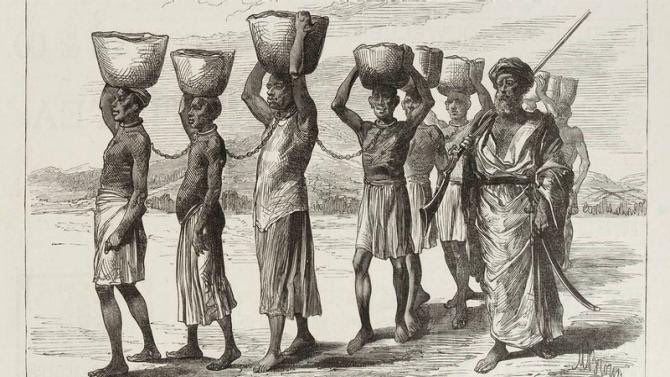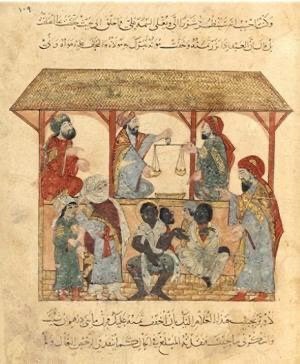An introduction to the Indian Ocean slave trade.
When many people think of slavery, they think of the translatlantic trade that took place between Africa, the Americas and the Caribbean. The legacy of enslavement in the Americas (particularly in the United States) is known...
When many people think of slavery, they think of the translatlantic trade that took place between Africa, the Americas and the Caribbean. The legacy of enslavement in the Americas (particularly in the United States) is known...
globally through the cultural and political impact of African-American iconography, films, history and references in popular culture. For many people of African descent across the world, it is one of the clearest historical links that binds them together, even if they do not have
west African or American ancestry. But the slave trade across the Atlantic Ocean is not the only history of longstanding mass global enslavement. Less well-known is a system that went on for centuries longer, but which took place across its opposite oceanmass, the Indian Ocean.
The Indian Ocean slave trade encompassed Africa, Asia and the Middle East, with people from these areas involved as both captors and captives.
The numbers of people enslaved and the exact length of the trans-Indian slave trade have not been definitively established, but historians believe that it preceded the transatlantic enslavement by centuries.
Even though it is largely ignored as an international slave trade,examples of its impact abound. Writing on Indian Ocean slavery frequently mentions African people in China & Persia as well as in the Muslim holy cities of Mecca & Medina,which also served as central slave markets.
The longevity of the Indian Ocean slave trade is also evident in key historical moments. Long before the slave revolt of Haiti under Toussaint L’Overture, which istouted as the most successful slave revolt in modern history, established the first black republic in the Western...
Hemisphere, African slaves in the southern Iraqi city Basra established political power centres in Iraq and parts of present-day Iran for a period of fourteen years. The Zanj rebellion, and subsequent rule of East African slaves in parts of Iraq, took place between 869-883AD1.
Centuries later, when American president Barack Obama was elected as the first African-American president in the United States, his election proved inspirational to their black descendants who continue to live in Basra.
But focussing solely on African people enslaved across Asia would be hiding the extent of Indian Ocean slavery: Asian people were enslaved for centuries as well, with Asian slaves who survived shipwrecks on European ships found living with the indigenous population on...
South Africa’s coast long before colonisation. There are also reports of Indian people enslaved and living in Kenya and Tanzania, and later, there was the large-scale movement of enslaved Asian people sent to work as slaves in colonial South Africa,
starting from Dutch colonisation in 1652. Enslaved Asian people in South Africa came from as far afield as Japan and Timor, but the majority were from India, Sri Lanka, Indonesia and China.
In addition, men from Baluchistan in present-day Pakistan are regularly mentioned working as guards in relation to the slaving community based in Tanzania in the 1800s, overseen by the Omani sultanate who ruled Zanzibar, & Indian & Chinese slaves were to be found in South Africa,
as well as in parts of the African eastern coast. The Ottoman Empire enslaved non-Muslim populations in the Balkans, and women were often the target for sexual slavery, hence the Orientalist “allure” of the harem, and likely the source of the term “white slavery”.
Afro-Turks also continue to live in Turkey. At its most pernicious, the effects of Asian enslavement is seen in contemporary racist European depictions of Asian women – which often have roots and metaphors in the sexual abuse inherent in the enslavement of Asian women and their..
status in the early days of colonialism.
There are other contemporary reverberations of the Indian Ocean slave trade – and continuing practices of enslavement in parts of north Africa, including in Mauritania. Enslavement of “African” populations by the “Arab” Sudanese ruling...
There are other contemporary reverberations of the Indian Ocean slave trade – and continuing practices of enslavement in parts of north Africa, including in Mauritania. Enslavement of “African” populations by the “Arab” Sudanese ruling...
class in Sudan was one of the key reasons for the breakup of the Republic of Sudan and the secession of South Sudan. Even today, being darker-skinned African is synonymous with being called abd/abeed (slave) by Arabs.
This includes Arab people who have been born and have lived all of their lives in western Europe and north America. (The Twitter hashtag #abeed will show you how prevalent and contemporary the epithet is.)
Words like “coolie” and “kaffir”, often associated with the Asian indentured labour system prevalent under later European colonialism, had roots and common usage in the periods of Indian Ocean slavery from the 1600s onwards.
Get more on this website: https://mediadiversified.org/2016/05/04/an-introduction-to-the-indian-ocean-slave-trade/

 Read on Twitter
Read on Twitter



